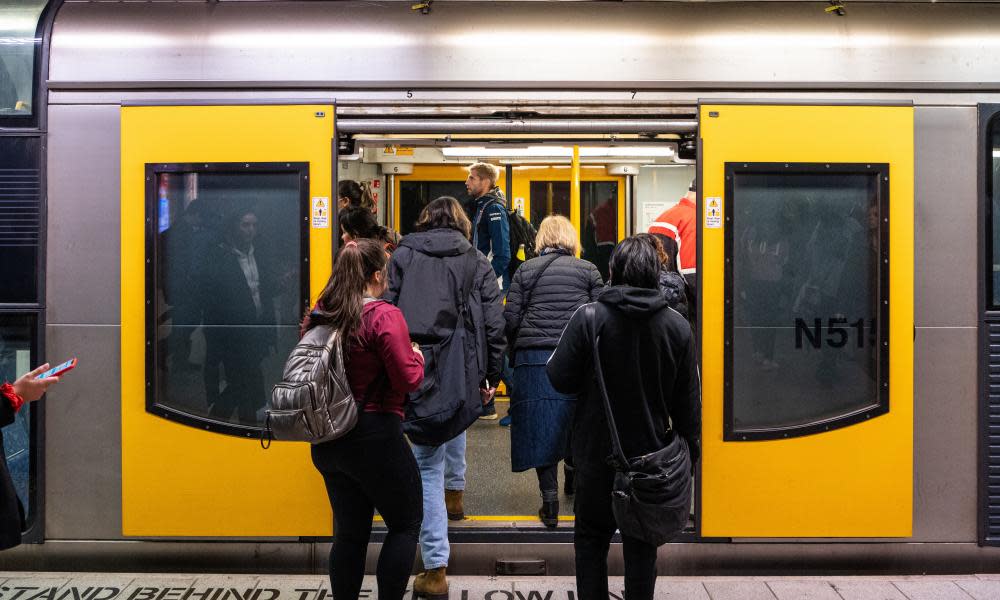More Australians head back to the office and most prefer Thursday or Friday, study finds

As an increasing number of Australians favour the office over working from home, Friday has emerged as one of the most popular days to commute and be among colleagues, new research shows.
On average Australian workers spent just 21% – or between one and two days – of their work week at home during a two-week survey period in September, down from a corresponding data point of 27% in March. This is according to the latest Transport Opinion Survey conducted by the University of Sydney’s Institute of Transport and Logistics Studies, based on data from 1,029 respondents, who were also asked about priorities and transport attitudes.
Related: ‘Time to go back’: city business owners rail against Australia’s working from home shift
It found that 51% said housing was their top concern, including ramifications for the cost of purchasing and renting, while 21% said they felt the higher costs of everyday travel, such as soaring petrol prices and public transport fares.
David Hensher, the director of the institute, which has run the transport survey twice a year for the past 10 years, said that the farther away an employee lived from their work, the more likely they were to work from home.
The uptick in return to the office has been largely driven by professionals and sales workers, said Hensher.
“We suspect this has got to do a lot with the pressure big companies are placing on professionals to come into the office,” Hensher said.
The research found that 42% of Australian employers have stipulated workers must return to the office for a particular number of days each week.
However, the nationwide figure combines different industries where work from home patterns vary wildly.
Related: The office returns: are the days of Australians working from home numbered?
While the spike in professionals and sales staff – who account for 37% of the workforce – returning to their offices over the last quarter has driven down the economy-wide average, the overall average is shaped by some industries where remote working is impractical.
According to the September survey, managers worked on average 2.7 days from home a week, professionals 1.8 days a week, machine operators just 0.7 and labourers for 0.2 days a week.
Work from home patterns also differ significantly between states. Melbourne had the highest rates of working from home of anywhere in Australia, an average of 2.06 days a week.
“In Melbourne we think they’re nervously still recovering from the lockdowns, which they had for much longer, so this is the sense of why working from home rates are so high in Victoria,” Hensher said.
Preferred days of office working have also shifted.
Monday, Tuesday and Wednesday have the highest levels of working from home, with 63%, 61% and 60% of those who work from home doing so on these three days respectively, the research said.
Fridays and Thursdays are least popular on which to work from home, with 52% and 55% of employees working from home on these days respectively.
Hensher said Friday had emerged as one of the more popular days to come into the office, for social reasons.
“The most important reason people go into offices is social interaction, as well as for junior employees to build a network,” he said.
“While some thought we would see working from home on Mondays and Fridays become most common, to have a feeling of a long weekend, we see people going in on Fridays more and one reason why might be because of social activities after work on Fridays,” Hensher said.
Crucially, these preferences differ between states.
In New South Wales, Thursdays are the most popular days to work from the office, with 45% of employees who do engage in remote working doing so on this day of the week.
In Sydney, the state government is still attempting to encourage workers into offices on Fridays, recently announcing it would subsidise public transport on this day to be in line with weekend prices.
With remote working becoming routine and flattening demand for the CBD across the week, survey respondents reported increased confidence in public transport.
“People are coming back to public transport … We think that generally speaking people are finding they can get a seat now, and the service is pretty damn good now,” Hensher said, noting countrywide improvements to public transport such as better on-schedule performance and fewer industrial actions since the last survey six months earlier.
However, levels of road traffic are worsening, in part because commuters working only some days from the office can justify the added cost of driving on the days they do go in, Hensher said.
“We’ve found that those people who are working at home more, drove to work more. They may have found it less expensive, so have been less sensitive to petrol and parking costs if they only have to pay for it two or three days per week.
“That is leading more people to drive, so it feels like there’s more traffic. While it might be bumper to bumper on the Cahill expressway [in Sydney], it’s not as bumper to bumper as it was during pre-Covid peaks.”
Additionally, Hensher said research had found a trend of increased traffic from leisure trips on suburban roads during the day, as those working from home ran errands and visited local cafes and businesses in spare time they had saved from not commuting.


